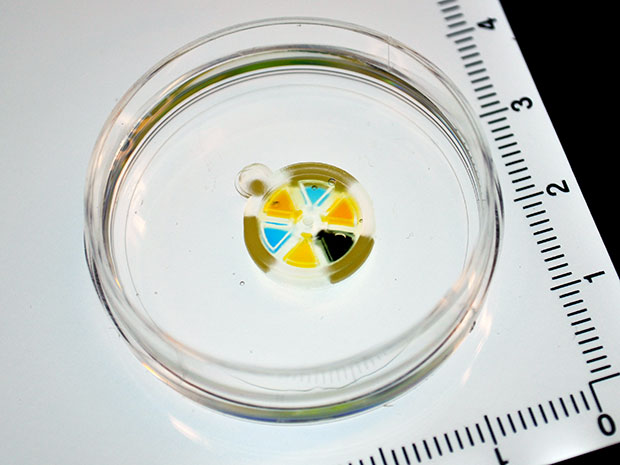Columbia University researchers from the Columbia University Irving Medical Center (CUMC), have established a method of growing human hair in a dish using 3D printing in a new study. It is reportedly the first time in which human hair follicles have been artificially generated in a dish, without the need for implantation into human skin. The breakthrough, enabled by a 3D printed mold, could potentially open avenues for hair restoration surgery to more people, as well as improving upon the current procedures that pharmaceutical companies use to search for hair growth drugs.
The study, titled “Tissue engineering of human hair follicles using a biomimetic developmental approach,” was published in Nature Communications. Erbil Abaci, PhD, first author of this study, explains the significance of using 3D printing in their research:
“Previous fabrication techniques have been unable to create such thin projections, so this work was greatly facilitated by innovations in 3D printing technology.”
The limits of growing human hair
Although the possibility of artificially growing hairs in the lab has been established for a number of years, it has been limited to the growth of mouse and rat hairs. Scientists would generate the hair by culturing cells taken from the base of the rodent’s follicles, however, human cells did not behave in the same manner: “Cells from rats and mice grow beautiful hairs,” Dr. Christiano explains, a specialist in regenerative therapies for skin and hair disorders and author on the paper. “But for reasons we don’t totally understand, human cells are resistant.”
In order to counter the resistance of human hair cells, Dr. Christiano has been attempting to replicate the 3D environment normally inhabited by them. The first attempt in developing these conditions involved the creation of ‘cell spheres’ inside hanging drops of liquid. However, when the scientists implanted these spheres of human cells inside the mice, the results were not concrete, as some people’s cells created new hair whereas others didn’t.
Using 3D printing to prevent hair loss
The new study demonstrates a method that utilized the intricate capabilities of 3D printing to help create a more natural microenvironment for human hair follicle growth, allowing it to be grown in a dish. Specifically, the team of CUMC researchers used 3D printing to create plastic molds with long, thin extensions only half a millimeter wide: “We exploit the unique capability of 3D-printing technology to create structures with high aspect ratios (length to width ratio: ~100 for human HFs13),” as described in the paper. These ratios were previously not possible with other fabrication methods, like soft lithography.
The team engineered human skin to grow around the mold, after which human hair follicle cells were implanted within the wells, and topped by keratin-producing cells (the main structural constituent of hair). Furthermore, the cells were injected with ingredients to help stimulate hair growth, and after a period of three weeks, human hair follicles appeared, and began to create hair.
Further optimization and refinement is required for the method, however, the researchers claim that, by using 3D printing, it could lead to an unlimited source of new hair follicles for patients undergoing robotic hair restoration surgery. “What we’ve shown is that we can basically create a hair farm: a grid of hairs that are patterned correctly and engineered so they can be transplanted back into that same patient’s scalp,” Dr. Christiano explains.

Hair restoration surgery often requires relocating transferring 2,000 hair follicles from the back of the head to the front and top. This is mostly reserved for male patients with stabilized hair loss on the back and sides, with enough hair to donate. Most women have the ‘diffuse’ type of hair loss, which represents an overall thinning in all areas of the head, including the sides and back where hair is required for donation. However, the study provides a route to overcome the limited availability of hair restoration surgery for women: “That expands the availability of hair restoration to all patients–including the 30 million women in the United States who experience hair thinning and young men whose hairlines are still receding. Hair restoration surgery would no longer be limited by the number of donor hairs,” added Dr. Christiano.
Other potential uses for the engineered hair follicle using 3D printing includes the screening for new hair growth drugs, which is hampered by inability to grow human hair follicles in a lab dish. In the pharmaceutical industry, no drugs have been found so far through screening, however the team hopes that its cultured hair farms will enable high throughput drug screens to identify new pathways that influence hair growth.
Continuous research into the capabilities of 3D printing at Columbia University
With this new study, scientists from Columbia University have demonstrated a continuous drive towards pushing the capabilities of 3D printing through a variety of research and experiments. Most recently in April 2019, Columbia University scientists developed a new method to 3D print cooked food, with the intention of overcoming the limitations of current 3D food printers (3DFPs).

Furthermore, researchers from the university have also shown a method to replicate the external and internal structure of wood using a 3D printer. With the help of imaging, color and voxel mapping techniques, Columbia University engineers were able to mimic the unique texture of olive wood. Finally, in 2017, a team from the university also developed a liquid-based mechanical system made from a 3D printed hydrogel that can be implanted in the body and controlled to release medication at will.
You can also keep connected by following us on Twitter and liking us on Facebook.
Looking for a career in additive manufacturing? Visit 3D Printing Jobs for a selection of roles in the industry.
Featured image shows the 3D printed hair follicle mold. Photo via Columbia University.

